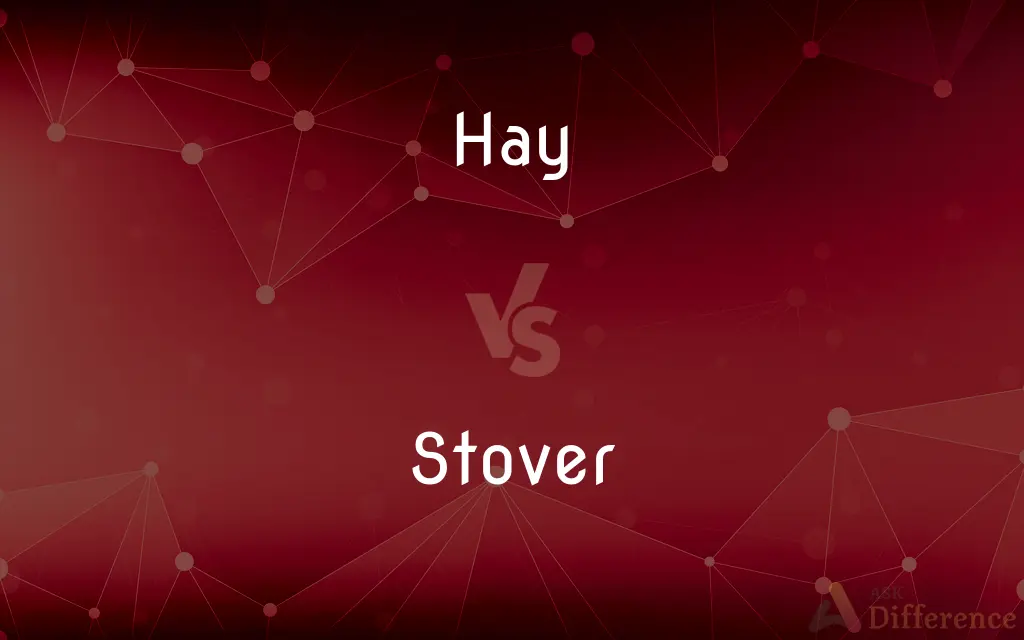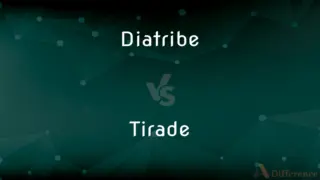Hay vs. Stover — What's the Difference?
Edited by Tayyaba Rehman — By Maham Liaqat — Updated on May 6, 2024
Hay consists of mowed and dried grasses or legumes used primarily for animal feed, especially for grazing animals, whereas stover refers to the leftover plant material from crops like corn or sorghum after the grain is harvested.

Difference Between Hay and Stover
Table of Contents
ADVERTISEMENT
Key Differences
Hay is typically made from grasses, legumes, or cereals that are cut, dried, and stored for use as animal fodder, particularly for grazing animals like cattle and horses. Whereas stover involves the residues left in fields after grains like corn, wheat, or sorghum are harvested, including stalks, leaves, and cobs.
The production of hay involves a critical drying process that preserves the nutritional value of the plant material, making it an essential feed that can be stored and used throughout the year. On the other hand, stover is not primarily intended for feed as it requires further processing to be digestible by livestock.
In terms of nutritional value, hay generally offers a higher level of nutrients such as proteins and carbohydrates, necessary for the dietary needs of ruminant animals. Conversely, stover typically has lower nutritional value and often needs to be supplemented with other feeds or treatments to be a viable feed option.
Hay production can support biodiversity in agricultural landscapes when managed sustainably, providing habitats for various wildlife species. While stover is often used in agricultural practices like no-till farming to enhance soil quality and reduce erosion.
Hay is a significant agricultural product with a well-established market, especially in rural areas where livestock farming is prevalent. While stover is sometimes seen as a byproduct, it has gained importance as a potential biofuel source, apart from its traditional uses in bedding and soil amendment.
ADVERTISEMENT
Comparison Chart
Composition
Grasses, legumes, cereals
Crop residues (stalks, leaves, cobs)
Primary Use
Animal feed
Soil amendment, biofuel, low-quality feed
Nutritional Value
High in proteins and carbohydrates
Generally lower nutritional content
Harvesting Process
Cut, dried, and baled
Collected after grain harvest
Ecological Impact
Enhances biodiversity, habitat provision
Improves soil structure, prevents erosion
Compare with Definitions
Hay
A harvested and dried plant material for feeding livestock.
They baled the hay before the onset of rain.
Stover
In agricultural discussions, refers to non-grain parts of plants left in the field.
Managing stover is important for preventing soil erosion.
Hay
In colloquial use, refers to something insignificant or easy.
That exam was a piece of hay, meaning it was very easy.
Stover
The remains of field crops gathered after the main harvest.
The stover from the harvested corn was plowed back into the field.
Hay
Used metaphorically to denote simple, basic necessities.
Make hay while the sun shines, meaning to make the most of one's opportunities.
Stover
Used in sustainable farming practices.
Incorporating stover into the soil helps retain moisture and nutrients.
Hay
A valuable farm product derived from grasslands.
Quality hay is essential for dairy cattle health.
Stover
A byproduct of grain crops like corn and wheat.
Corn stover has potential as a biofuel source.
Hay
Dried grasses or legumes used as animal feed.
The farmer stocked the barn with hay for the winter.
Stover
Crop residues used for fodder, fuel, or bedding.
Stover is often used to bed livestock in barns.
Hay
Hay is grass, legumes, or other herbaceous plants that have been cut and dried to be stored for use as animal fodder, particularly for large grazing animals raised as livestock, such as cattle, horses, goats, and sheep. However, it is also fed to smaller domesticated animals such as rabbits and guinea pigs.
Stover
Stover is the leaves and stalks of field crops, such as corn (maize), sorghum or soybean that are commonly left in a field after harvesting the grain. It is similar to straw, the residue left after any cereal grain or grass has been harvested at maturity for its seed.
Hay
Grass or other plants, such as clover or alfalfa, cut and dried for fodder.
Stover
The dried stalks and leaves of a cereal crop, used as fodder after the grain has been harvested.
Hay
(Slang) A trifling amount of money
Gets $100 an hour, which isn't hay.
Stover
Fodder for cattle, especially straw or coarse hay.
Hay
To mow and cure grass and herbage for hay.
Stover
Stalks and leaves, not including grain, of certain forages
Hay
To make hay on (a patch of land).
Stover
Fodder for cattle, especially straw or coarse hay.
Where live nibbling sheep,And flat meads thatched with stover them to keep.
Thresh barley as yet but as need shall require,Fresh threshed for stover thy cattle desire.
Hay
To make (grass or other plants) into hay.
Stover
The dried stalks and leaves of a field crop (especially corn) used as animal fodder after the grain has been harvested
Hay
To feed with hay.
Hay
(uncountable) Grass cut and dried for use as animal fodder.
Hay
(countable) Any mix of green leafy plants used for fodder.
Hay
(slang) Cannabis; marijuana.
Hay
A net set around the haunt of an animal, especially a rabbit.
Hay
(obsolete) A hedge.
Hay
(obsolete) A net placed around the lair or burrow of an animal.
Hay
(obsolete) An enclosure, haw.
Hay
(obsolete) A circular country dance.
Hay
The letter for the h sound in Pitman shorthand.
Hay
To cut grasses or herb plants for use as animal fodder.
Hay
To lay snares for rabbits.
Hay
A hedge.
Hay
A net set around the haunt of an animal, especially of a rabbit.
Hay
Grass cut and cured for fodder.
Make hay while the sun shines.
Hay may be dried too much as well as too little.
Hay
To lay snares for rabbits.
Hay
To cut and cure grass for hay.
Hay
Grass mowed and cured for use as fodder
Common Curiosities
How is stover different from hay?
Stover consists of crop residues left after harvesting grains, unlike hay which is specifically grown and processed for feed.
What is hay used for?
Hay is primarily used as fodder for grazing animals like cattle and horses.
Is hay nutritious?
Yes, hay provides essential nutrients that are vital for the health of livestock.
What crops produce stover?
Crops like corn, wheat, and sorghum leave behind stover after the grains are harvested.
How is hay made?
Hay is made by cutting, drying, and baling grasses or legumes.
What happens to stover after harvest?
It can be collected and used as feed, soil amendment, or left in the field to decompose.
Why is hay important in agriculture?
Hay is crucial for livestock farming, providing a reliable source of fodder throughout the year.
Can stover be fed to animals?
Yes, but it often requires treatment or mixing with other feeds due to its lower nutritional content.
What is the environmental impact of hay production?
When managed sustainably, hay production can support biodiversity and provide habitat for wildlife.
How do farmers handle surplus stover?
Surplus stover can be sold for biofuel production or used as organic matter in fields.
Can stover be used for anything besides feed?
Yes, it is also used for biofuel production, soil amendment, and as bedding in animal husbandry.
What are the challenges of using stover as feed?
Its lower nutritional value and the need for additional processing pose challenges for direct use as livestock feed.
What is the cost difference between hay and stover?
Hay tends to be more expensive due to its higher nutritional value and processing costs.
How do farmers ensure the quality of hay?
Quality is maintained by controlling moisture levels during baling and storage to prevent spoilage.
Can all types of livestock eat hay?
Yes, most grazing livestock can eat hay, which is often tailored to meet specific dietary requirements.
Share Your Discovery

Previous Comparison
Drunken vs. Drunk
Next Comparison
Diatribe vs. TiradeAuthor Spotlight
Written by
Maham LiaqatEdited by
Tayyaba RehmanTayyaba Rehman is a distinguished writer, currently serving as a primary contributor to askdifference.com. As a researcher in semantics and etymology, Tayyaba's passion for the complexity of languages and their distinctions has found a perfect home on the platform. Tayyaba delves into the intricacies of language, distinguishing between commonly confused words and phrases, thereby providing clarity for readers worldwide.
















































